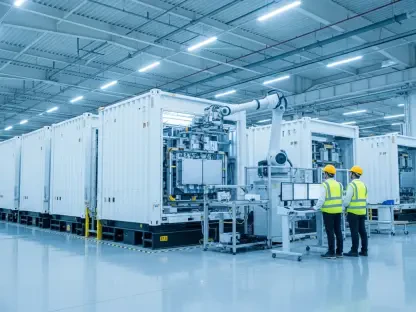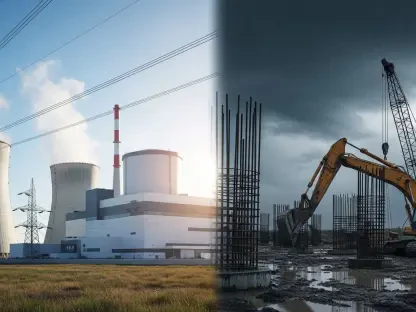The global market for cement kiln co-processing fuels is on the verge of significant growth, driven by an increasing need for sustainable waste management and alternative energy solutions. With projections estimating the market’s valuation at USD 6,747.2 million by 2034, this trend is primarily influenced by a combination of regulatory pressures, economic incentives, and advancements in waste processing technologies. The adoption of co-processing fuels in cement production not only addresses environmental challenges but also aligns with broader economies’ goals towards sustainability and reduced reliance on traditional fossil fuels.
Increasing Adoption of Plastic Waste in Cement Production
One of the most striking trends in the cement kiln co-processing fuels market is the escalating use of plastic waste. Traditionally a challenging material to manage, plastic waste is now finding new life as a valuable feedstock for cement kilns. This strategic integration not only helps address the growing plastic waste crisis but also reduces the cement industry’s reliance on conventional fossil fuels, offering an environmentally sustainable and economically viable solution. Plastic waste in cement production processes provides dual benefits by mitigating the environmental impact of plastic waste while offering an alternative energy source for cement kilns.
This approach aligns seamlessly with global sustainability goals and supports the principles of the circular economy by transforming waste into a valuable resource. As the world grapples with the plastic waste problem, the innovative repurposing of plastic waste as a fuel source is an important step towards achieving environmental and economic balance. The increasing use of plastic waste in cement kilns signifies convergence between waste management solutions and the pursuit of cleaner, more efficient energy sources. Furthermore, utilizing plastic waste reduces the environmental footprint of cement production, contributing significantly to global efforts aimed at combating climate change and fostering sustainable industrial practices.
Rising Demand for Solid Recovered Fuel (SRF)
Solid Recovered Fuel (SRF) is also gaining notable traction in the cement industry as an alternative fuel source. Derived from non-recyclable waste such as municipal solid waste (MSW) and industrial by-products, SRF offers a high calorific value that is essential for clinker production. This shift towards SRF is driven by its environmental benefits, cost-effectiveness, and lower greenhouse gas emissions. The environmental advantages of SRF are profound, as it helps divert significant amounts of waste from landfills while providing a cleaner energy alternative. By replacing fossil fuels like coal, SRF reduces the carbon footprint of cement production, aligning with global climate action aims.
Cost-effectiveness is another key driver behind the adoption of SRF. Cement manufacturers can achieve substantial cost savings by using SRF, which is often up to 50% cheaper than coal. The economic incentives are further strengthened as industrial sectors find it financially advantageous to pay cement producers to manage hazardous waste, transforming waste disposal costs into potential revenue streams. This financial dynamic not only benefits the cement industry but also supports broader waste management and economic efficiency objectives. The rising popularity of SRF underscores a growing recognition of its potential to deliver both environmental sustainability and economic benefits, reinforcing the cement industry’s commitment to innovative and responsible energy solutions.
Stringent Environmental Regulations and Policy Support
Governments worldwide are imposing stringent environmental regulations aimed at reducing carbon emissions and promoting sustainable waste management, thereby compelling the cement industry to adopt alternative fuels. These policies are particularly notable in regions such as Europe, China, and the United States, where regulatory frameworks are driving the use of co-processing fuels. Legislative support for co-processing fuels in cement production is crucial for the market’s growth, as these policies not only encourage adoption but also support the broader aims of the circular economy. By minimizing landfill waste and reducing the environmental impact associated with cement production, these regulations foster a more sustainable industry.
Environmental regulations are instrumental in shaping the market dynamics for co-processing fuels. By mandating reduced carbon emissions and encouraging waste-to-energy solutions, governments are steering the cement industry towards more sustainable and efficient practices. The regulatory landscape is continuously evolving, with increasing emphasis on sustainability and environmental stewardship, thus creating a conducive environment for the adoption of co-processing fuels. Compliance with these regulations not only ensures adherence to legal standards but also enhances the industry’s overall sustainability profile, positioning it as a responsible and forward-thinking sector committed to reducing its environmental footprint.
Economic Benefits from Alternative Fuels
As traditional fossil fuel prices continue to rise, cement manufacturers are increasingly turning to economical alternatives such as SRF and plastic waste. SRF, in particular, offers significant cost advantages, being up to 50% cheaper than coal. This compelling economic incentive drives the industry’s transition towards alternative fuels. Moreover, the financial dynamics of the industry are evolving, with industrial sectors finding it beneficial to pay cement producers to manage hazardous waste. This transformation of waste disposal costs into potential revenue not only enhances the economic viability of co-processing fuels but also supports broader economic efficiency goals.
The cost savings associated with using alternatives like SRF and plastic waste are substantial, offering the cement industry a more financially sustainable production model. By reducing reliance on expensive fossil fuels, manufacturers can achieve considerable savings, directly impacting their bottom line. Additionally, using waste materials as fuel sources creates new revenue streams, further strengthening the economic case for co-processing fuels. The integration of these economic benefits with environmental and regulatory incentives paints a comprehensive picture of a market poised for robust growth, driven by a synergistic blend of sustainability and financial prudence.
Regional Insights and Growth Projections
The cement kiln co-processing fuels market is expected to experience considerable growth across various regions, each demonstrating unique drivers and potential. For instance, Spain is projected to witness a growth CAGR of 9.3%, highlighting significant market expansion potential driven by local regulatory frameworks and economic incentives. Similarly, India is expected to grow at a CAGR of 6.7%, reflecting the region’s rapid industrialization and commitment to sustainable practices. Brazil, France, and South Korea also show promising growth rates of 7.5%, 6.9%, and 6.2%, respectively, underscoring the global nature of the market’s expansion.
Regions are adopting co-processing fuels at varying rates based on local conditions, regulatory landscapes, and availability of waste materials. These diverse growth projections indicate widespread potential for co-processing fuels, with each region contributing uniquely to the market’s overall trajectory. The ability of different regions to integrate co-processing fuels into their industrial processes not only speaks to the adaptability of these solutions but also showcases the universal appeal and applicability of co-processing practices in addressing global sustainability challenges. This global momentum reinforces the cement industry’s pivotal role in fostering a sustainable and economically viable future through innovative waste-to-energy solutions.
Technological Advancements in Waste Processing
Technological advancements in waste processing are crucial in driving the growth of the cement kiln co-processing fuels market. Innovations in waste sorting, shredding, and drying have simplified converting waste into usable fuels, enhancing the quality and consistency of alternative fuels. These advancements are instrumental in improving kiln performance, enabling more efficient and effective use of waste materials as fuel sources. The development of advanced pre-processing technologies is ensuring that alternative fuels meet the stringent quality standards required for optimal combustion and energy output in cement kilns.
These technological innovations are not only enhancing the feasibility of using alternative fuels but also paving the way for more sustainable and eco-friendly industrial practices. By improving the processing and preparation of waste materials, these technologies are helping cement manufacturers optimize their operations, achieve better environmental outcomes, and realize significant economic savings. The continuous evolution of waste processing technologies is a testament to the industry’s commitment to embracing cutting-edge solutions that contribute to broader sustainability and economic efficiency goals. As these technologies advance, the potential for expanding the use of co-processing fuels in cement production continues to grow, reinforcing the industry’s role in promoting innovative and sustainable energy solutions.
Challenges in the Adoption of Co-Processing Fuels
The global market for cement kiln co-processing fuels is on the cusp of tremendous growth, driven by an increasing need for sustainable waste management and alternative energy sources. Projections estimate the market’s value will reach USD 6,747.2 million by 2034. This upward trend is influenced by a mix of regulatory pressures, economic incentives, and advancements in waste processing technologies. The use of co-processing fuels in cement production not only helps tackle environmental challenges but also aligns with broader economic goals of sustainability and reducing dependence on traditional fossil fuels.
Several factors are contributing to this market growth. Governments around the world are implementing strict regulations to reduce carbon emissions and encourage green technologies. These regulations are pushing industries to adopt more sustainable practices, like using alternative fuels in cement kilns. Moreover, economic incentives, such as tax breaks and subsidies, are making it financially viable for companies to invest in these greener solutions. Advancements in technology are also making waste processing more efficient and cost-effective, further driving the adoption of co-processing fuels.
In the long term, the integration of co-processing fuels in cement production supports the goals of reducing environmental impact and enhancing energy security. This path aligns with global efforts to pivot towards more sustainable industrial processes, which are less reliant on conventional fossil fuels and mark a significant step towards a cleaner, more sustainable future.









